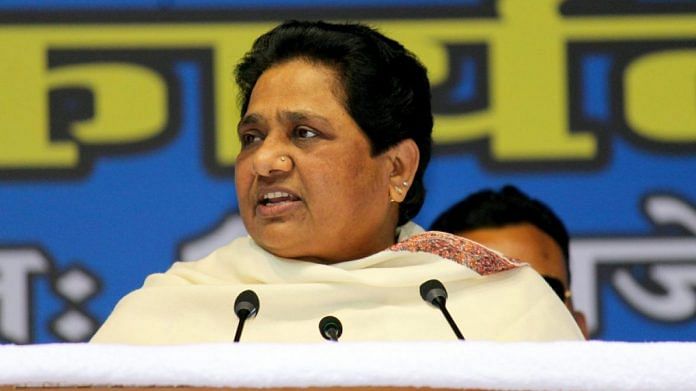Her aides maintain she may be open to any post-poll arrangements, but being part of an opposition alliance suits her best at this stage.
Bahujan Samaj Party (BSP) supremo Mayawati was one of the few leaders to get the privilege of seeing former prime minister Atal Bihari Vajpayee in his last hours at AIIMS in the national capital.
She spent half-an-hour at the hospital and left quietly, but political circles have been abuzz with speculation surrounding that ‘privilege’ since then. Senior government functionaries apparently intervened with the doctors to fulfil her wish.
The conspiratorial tone about a party chief being allowed to see a former PM on his deathbed may sound a bit cynical, especially when she has been critical of the ruling party at the Centre and holding seat-sharing negotiations with opposition Congress leaders such as Ahmed Patel and Kamal Nath. After all, she was also quick to remove a party vice-president, Jai Prakash Singh, for saying that Rahul Gandhi has “foreign blood in his veins” and so he is not fit to become the prime minister.
Also read: Congress analysts say UPA could touch 200 in Lok Sabha polls with help from Mayawati
Yet, nobody is sure about Mayawati’s politics. She and her mentor, Kanshi Ram, never had any issues in striking deals with parties, regardless of their ideological hues. The BJP had propped her up as Uttar Pradesh chief minister thrice in the past, including in 1997 when the BSP abandoned its pre-poll alliance partner, the Congress, to join hands with the saffron party.
As her prospective alliance with other opposition parties threatens to upset the BJP’s calculations in UP in 2019 general elections, the saffron party’s emissaries are said to have gotten in touch with her again. But her close aides maintain she may be open to any post-poll arrangements, but being part of an opposition alliance suits her best at this stage.
For a non-BJP, non-Congress party leader to become the prime minister of India in 2019, his/her party should have 40-50 MPs because the Congress is limited to 120-130 seats, say political strategists belonging to different parties.
This debate may appear premature and hypothetical today – especially with Prime Minister Narendra Modi remaining the most popular leader despite a dip in his popularity ratings and Congress president Rahul Gandhi making no bones about his being the PM-in-waiting. But, there is tremendous optimism in the BSP camp and its leaders are confident of easily reaching or crossing that figure. And, that explains the curiosity and anxiety in the opposition quarters about the ‘privilege’ accorded to Mayawati at AIIMS.
Also read: Rahul Gandhi’s 2019 choice between Mamata & Mayawati depends on who is his mother’s friend
She has a clear advantage vis-à-vis other contenders in a non-Congress, non-BJP government. The BSP is likely to contest around half of the 80 seats even in an alliance with the Congress, the Samajwadi Party and the Rashtriya Lok Dal in UP.
Besides, the party is expecting to contest “at least 40 more seats” in Maharashtra, Karnataka, Haryana, Chhattisgarh, Rajasthan and Madhya Pradesh in separate alliances with regional and national parties. Given other parties’ relatively limited areas of influence, Mayawati clearly enjoys an edge over her contenders.
The BSP chief may not be vocal about her ambitions but she has already started placing her knights, bishops and rooks at vantage positions on the electoral chessboard. She was photographed tying rakhi to Indian National Lok Dal leader Abhay Chautala last week. The two have already announced their alliance for Haryana assembly and Lok Sabha elections, with Chautala declaring her the prime ministerial candidate in April.
INLD was an NDA constituent from 1998 to 2004. It has split ties with the BJP but has been supporting the NDA-2 government on most issues in Parliament.
Mayawati will also address the INLD’s 25 September rally in Gohana, Haryana, to mark the 105th birth anniversary of party founder and former deputy PM Devi Lal. Several regional chieftains have been invited to this rally in a move to provide a platform for the projection of a non-Congress, non-BJP front.
Mayawati recently held a meeting with former Chhattisgarh chief minister Ajit Jogi, who quit the Congress to float his own party, the Janta Congress Chhattisgarh, and is accused by his former party colleagues of being hand-in-glove with the BJP. BSP leaders say she would prefer to have an alliance with Jogi for a “formidable Dalit-adivasi” consolidation in Chhattisgarh.
Also read: Mayawati should give up her prime ministerial ambitions
The BSP had an alliance with the Janata Dal (Secular) in the Karnataka assembly election and is expecting to contest a few Lok Sabha seats as part of the Congress-JD(S) alliance in 2019 elections. JD(S) supremo H.D. Deve Gowda, who became the prime minister when the Janata Dal had only 46 MPs in 1996, recently asked why Mayawati or Mamata Banerjee shouldn’t become the PM.
This question is likely to crop up more frequently in the run-up to and in the aftermath of the Lok Sabha elections next year if there is a deeply fractured verdict.




India’s experience between 1989 and 1991, then between 1996 and 1998, was not a happy one. We are almost certainly back to an extended era of coalition politics. However, first NDA and then UPA provided political stability over 16 years, with the large national party at its core and in the leadership position. 2. Ms Mayawati ticks two boxes. Seeing her governance style in Uttar Pradesh, not sure if she is of prime ministerial timbre. However, this churn underlines the fact that, with each passing day, 2019 is looking more and more unpredictable.